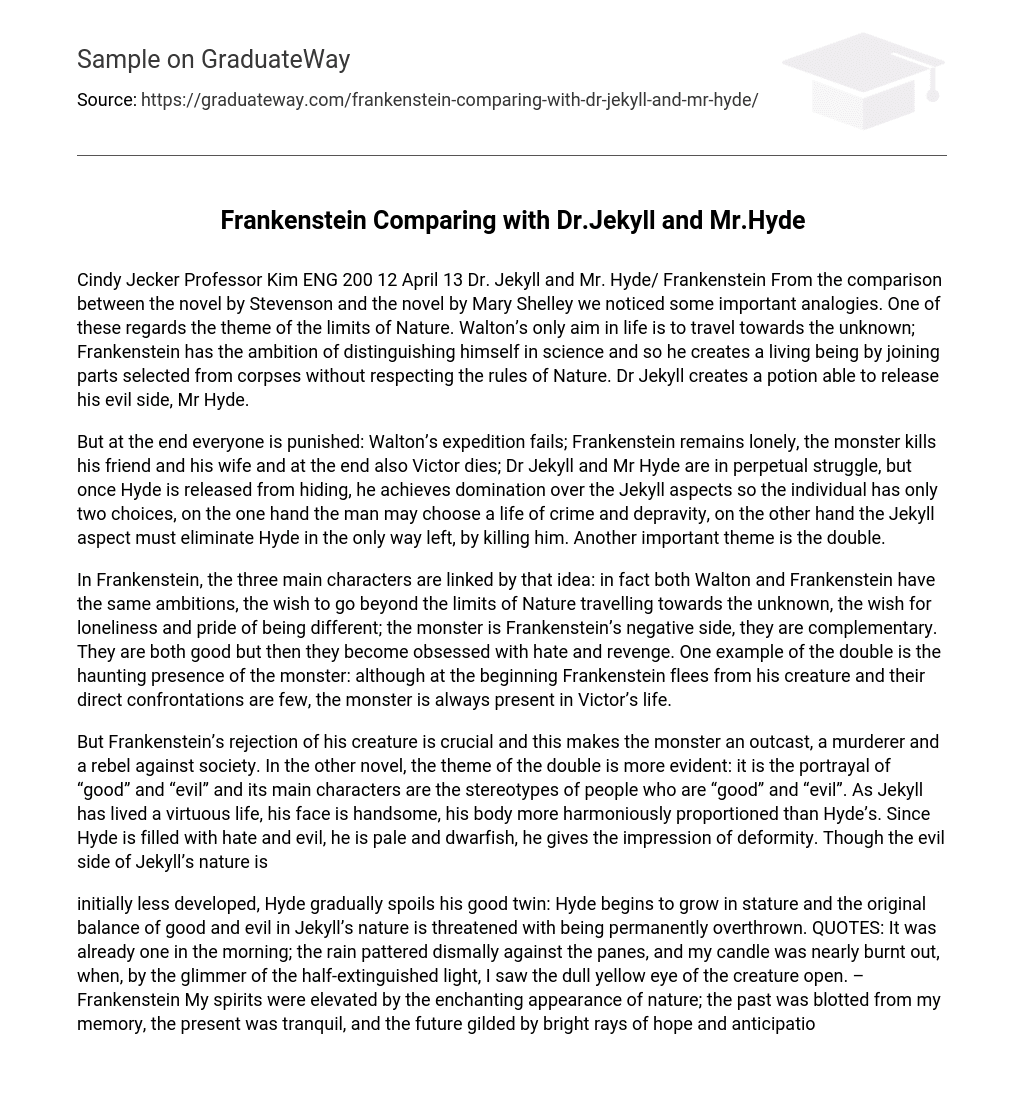Cindy Jecker
Professor Kim
ENG 200
12 April 13
Dr. Jekyll and Mr. Hyde/ Frankenstein
In comparing Stevenson’s novel with Mary Shelley’s, we notice some important analogies, particularly regarding the theme of the limits of nature.
Walton’s sole aim in life is to travel towards the unknown. Frankenstein has the ambition of distinguishing himself in science, so he creates a living being by joining parts selected from corpses without respecting the rules of nature. Dr. Jekyll creates a potion able to release his evil side, Mr Hyde.
However, in the end, everyone is punished. Walton’s expedition fails, leaving him with nothing to show for his efforts. Frankenstein remains lonely and tormented by the consequences of his actions. The monster he created kills both his friend and wife, ultimately leading to Victor’s own demise. Similarly, Dr Jekyll and Mr Hyde are constantly at odds with each other. When Hyde is finally released from hiding, he gains control over Jekyll’s personality, leaving the individual with only two options: a life of crime and depravity or eliminating Hyde by killing him. Another significant theme present in these works is that of duality.
In Frankenstein, the three main characters are linked by a common idea. In fact, both Walton and Frankenstein share the same ambition – to go beyond the limits of nature and travel towards the unknown. They also share a desire for loneliness and take pride in being different. The monster represents Frankenstein’s negative side, making them complementary. Initially, they were both good but later became obsessed with hate and revenge. One example of duality is the constant presence of the monster in Victor’s life. Although at first, Frankenstein flees from his creature and their direct confrontations are few, the monster remains an ever-present force.
Frankenstein’s rejection of his creature is crucial, making the monster an outcast, murderer, and rebel against society. In contrast, the theme of duality is more evident in the other novel. It portrays good” and “evil,” with its main characters stereotyped as such. Jekyll has lived a virtuous life; thus, his face is handsome, and his body is more harmoniously proportioned than Hyde’s. Since Hyde is filled with hate and evil, he appears pale and dwarfish – giving off an impression of deformity. Although Jekyll’s evil side
Initially less developed, Hyde gradually spoils his good twin. As a result, Hyde begins to grow in stature and the original balance of good and evil in Jekyll’s nature is threatened with being permanently overthrown.
It was already one in the morning; the rain pattered dismally against the panes, and my candle was nearly burnt out, when, by the glimmer of the half-extinguished light, I saw the dull yellow eye of the creature open.” –Frankenstein
My spirits were elevated by the enchanting appearance of nature. The past was blotted from my memory, and the present was tranquil. The future gilded by bright rays of hope and anticipations of joy.
I am alone and miserable; man will not associate with me; but one as deformed and horrible as myself would not deny herself to me. My companion must be of the same species and have the same defects. This being you must create.” – Frankenstein
“With every passing day, I drew closer to the truth from both sides of my intelligence, moral and intellectual. And by discovering this partial truth, I have been doomed to such a dreadful shipwreck: that man is not truly one, but truly two.” – Frankenstein
Jekyll and Mr. Hyde” explores the moral duality of man. Through my own experiences, I came to understand that within each person there are two opposing natures. These conflicting forces battle for control within our consciousness, making it impossible to identify as solely one or the other. From an early age, I found comfort in imagining the separation of these elements as a cherished daydream.





